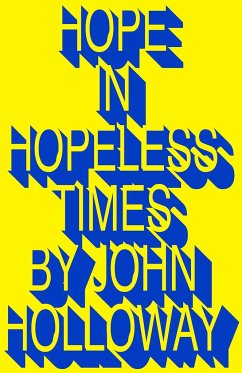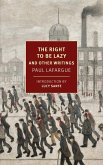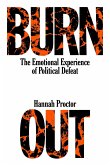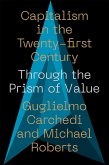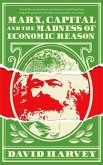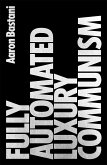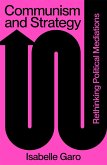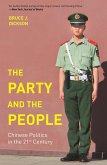John Holloway (Benemerita Universidad Autonoma de Puebla)
Hope in Hopeless Times
16,99 €
inkl. MwSt.
Sofort lieferbar

8 °P sammeln
John Holloway (Benemerita Universidad Autonoma de Puebla)
Hope in Hopeless Times
- Broschiertes Buch
- Merkliste
- Auf die Merkliste
- Bewerten Bewerten
- Teilen
- Produkt teilen
- Produkterinnerung
- Produkterinnerung
At a low point for the left, one of the world's leading Marxist philosophers demonstrates the grounds for revolutionary hope
Andere Kunden interessierten sich auch für
![The Right to Be Lazy The Right to Be Lazy]() Paul LafargueThe Right to Be Lazy10,99 €
Paul LafargueThe Right to Be Lazy10,99 €![Burnout Burnout]() Hannah ProctorBurnout12,99 €
Hannah ProctorBurnout12,99 €![Capitalism in the 21st Century Capitalism in the 21st Century]() Guglielmo Carchedi (Amsterdam University)Capitalism in the 21st Century22,99 €
Guglielmo Carchedi (Amsterdam University)Capitalism in the 21st Century22,99 €![Marx, Capital and the Madness of Economic Reason Marx, Capital and the Madness of Economic Reason]() David HarveyMarx, Capital and the Madness of Economic Reason9,99 €
David HarveyMarx, Capital and the Madness of Economic Reason9,99 €![Fully Automated Luxury Communism Fully Automated Luxury Communism]() Aaron BastaniFully Automated Luxury Communism10,99 €
Aaron BastaniFully Automated Luxury Communism10,99 €![Communism and Strategy Communism and Strategy]() Isabelle GaroCommunism and Strategy16,99 €
Isabelle GaroCommunism and Strategy16,99 €![The Party and the People The Party and the People]() Bruce J. DicksonThe Party and the People19,99 €
Bruce J. DicksonThe Party and the People19,99 €-
-
-
At a low point for the left, one of the world's leading Marxist philosophers demonstrates the grounds for revolutionary hope
Hinweis: Dieser Artikel kann nur an eine deutsche Lieferadresse ausgeliefert werden.
Hinweis: Dieser Artikel kann nur an eine deutsche Lieferadresse ausgeliefert werden.
Produktdetails
- Produktdetails
- Verlag: Pluto Press
- Seitenzahl: 283
- Erscheinungstermin: 20. Oktober 2022
- Englisch
- Abmessung: 214mm x 138mm x 21mm
- Gewicht: 326g
- ISBN-13: 9780745347349
- ISBN-10: 0745347347
- Artikelnr.: 64224694
- Herstellerkennzeichnung
- Libri GmbH
- Europaallee 1
- 36244 Bad Hersfeld
- gpsr@libri.de
- Verlag: Pluto Press
- Seitenzahl: 283
- Erscheinungstermin: 20. Oktober 2022
- Englisch
- Abmessung: 214mm x 138mm x 21mm
- Gewicht: 326g
- ISBN-13: 9780745347349
- ISBN-10: 0745347347
- Artikelnr.: 64224694
- Herstellerkennzeichnung
- Libri GmbH
- Europaallee 1
- 36244 Bad Hersfeld
- gpsr@libri.de
John Holloway has published widely on Marxist theory, on the Zapatista movement and on the new forms of anti-capitalist struggle. His book Change the World without Taking Power has been translated into eleven languages and has stirred an international debate, and Crack Capitalism is a renowned classic. He is currently Professor of Sociology in the Instituto de Ciencias Sociales y Humanidades of the Benemérita Universidad Autónoma de Puebla in Mexico.
Preface: Stop that train
Part I Rage-Hope-Richness
1. Today, any day.
2. Start again. Not from fear but from hope. Not from containment but
from overflowing.
3. Better, start from antagonism, from struggle.
4. Start from anguish, from Janus. Start from Not Enough! Start from the
hydra that we must slay.
Part II We must re-learn hope
1. It is time to re-learn hope.
2. To learn hope is to learn to think hope: a docta spes.
3. Hope pushes beyond identity.
4. Our hope starts from the scream, not from absence.
5. The Scream takes us in a negative direction, to overflow.
6. Beyond negative thought: Thinking In-Against-and-Beyond.
Part III Historicity
7. Hope-against is rooted in historicity.
8. Historicity does not mean historical materialism.
9. There is a Grand Narrative: the train taking us towards Destruction. It is
a narrative to be broken.
Part IV The Subject
10. Hope is not for victims, nor for heroes.
11. Richness is the revolutionary subject.
12. Listen to the latent Richness.
13. Listen again: there is a deeper level of latency.
14. Turn it all upside down, feel sorry for the capitalists.
Part V The Object: Money
15. Hope is a movement of the subject against an object: a breaking against a
binding.
16. The links in the chain of destruction are difficult to break.
17. The weakness of the binding lies not in the links between the forms but in
their internal antagonisms.
18. Unbinding the binding: Revolutionising revolution.
19. Richness against the commodity: the world faces two ways.
Part VI Think hope, think crisis
20. A theory of hope requires an understanding of the weakness or crisis of its
object, the hoped-against.
21. Crisis is inherent in capital.
22. From crisis to restructuring, or not: this is the salto mortale of capital.
Part VII Crisis postponed
23. Hope confronts the Hydra of Money.
24. Money rules. Money is the serial killer destroying us all.
25. Capital today is increasingly fictitious. Money is ill.
26. We are the subjects of the crisis of money.
27. Putting off disaster is the central principle of political economy. The
abandonment of the gold standard opens the way to mob rule.
28. The war created the golden age of capital. Its crisis broke the link
between gold and money.
29. The Volcker shock: the last attempt to impose sound money.
30. Black Monday: Debt takes off.
31. The breach between money and value continues to grow: a series of heart
attacks.
32. The fragility of capital explodes in the financial crisis of 2007/2008.
Heart attack number 2?
33. The storm is on the horizon: Fire Next Time.
34. The storm breaks: the Coronacrisis.
35. The Great Fragility deepens.
Part VIII A Book in search of a Conclusion. Hope in search of a Happy
Ending
36. The Container cannot contain.
37. We are Rabble-Richness-Resistance-Rebellion.
38. From Rage to Dignified Rage, Rabia to Digna Rabia.
39. Emancipate richnesses!
40. Not enough.
Thanks
Notes
Bibliography
Index
Part I Rage-Hope-Richness
1. Today, any day.
2. Start again. Not from fear but from hope. Not from containment but
from overflowing.
3. Better, start from antagonism, from struggle.
4. Start from anguish, from Janus. Start from Not Enough! Start from the
hydra that we must slay.
Part II We must re-learn hope
1. It is time to re-learn hope.
2. To learn hope is to learn to think hope: a docta spes.
3. Hope pushes beyond identity.
4. Our hope starts from the scream, not from absence.
5. The Scream takes us in a negative direction, to overflow.
6. Beyond negative thought: Thinking In-Against-and-Beyond.
Part III Historicity
7. Hope-against is rooted in historicity.
8. Historicity does not mean historical materialism.
9. There is a Grand Narrative: the train taking us towards Destruction. It is
a narrative to be broken.
Part IV The Subject
10. Hope is not for victims, nor for heroes.
11. Richness is the revolutionary subject.
12. Listen to the latent Richness.
13. Listen again: there is a deeper level of latency.
14. Turn it all upside down, feel sorry for the capitalists.
Part V The Object: Money
15. Hope is a movement of the subject against an object: a breaking against a
binding.
16. The links in the chain of destruction are difficult to break.
17. The weakness of the binding lies not in the links between the forms but in
their internal antagonisms.
18. Unbinding the binding: Revolutionising revolution.
19. Richness against the commodity: the world faces two ways.
Part VI Think hope, think crisis
20. A theory of hope requires an understanding of the weakness or crisis of its
object, the hoped-against.
21. Crisis is inherent in capital.
22. From crisis to restructuring, or not: this is the salto mortale of capital.
Part VII Crisis postponed
23. Hope confronts the Hydra of Money.
24. Money rules. Money is the serial killer destroying us all.
25. Capital today is increasingly fictitious. Money is ill.
26. We are the subjects of the crisis of money.
27. Putting off disaster is the central principle of political economy. The
abandonment of the gold standard opens the way to mob rule.
28. The war created the golden age of capital. Its crisis broke the link
between gold and money.
29. The Volcker shock: the last attempt to impose sound money.
30. Black Monday: Debt takes off.
31. The breach between money and value continues to grow: a series of heart
attacks.
32. The fragility of capital explodes in the financial crisis of 2007/2008.
Heart attack number 2?
33. The storm is on the horizon: Fire Next Time.
34. The storm breaks: the Coronacrisis.
35. The Great Fragility deepens.
Part VIII A Book in search of a Conclusion. Hope in search of a Happy
Ending
36. The Container cannot contain.
37. We are Rabble-Richness-Resistance-Rebellion.
38. From Rage to Dignified Rage, Rabia to Digna Rabia.
39. Emancipate richnesses!
40. Not enough.
Thanks
Notes
Bibliography
Index
Preface: Stop that train
Part I Rage-Hope-Richness
1. Today, any day.
2. Start again. Not from fear but from hope. Not from containment but
from overflowing.
3. Better, start from antagonism, from struggle.
4. Start from anguish, from Janus. Start from Not Enough! Start from the
hydra that we must slay.
Part II We must re-learn hope
1. It is time to re-learn hope.
2. To learn hope is to learn to think hope: a docta spes.
3. Hope pushes beyond identity.
4. Our hope starts from the scream, not from absence.
5. The Scream takes us in a negative direction, to overflow.
6. Beyond negative thought: Thinking In-Against-and-Beyond.
Part III Historicity
7. Hope-against is rooted in historicity.
8. Historicity does not mean historical materialism.
9. There is a Grand Narrative: the train taking us towards Destruction. It is
a narrative to be broken.
Part IV The Subject
10. Hope is not for victims, nor for heroes.
11. Richness is the revolutionary subject.
12. Listen to the latent Richness.
13. Listen again: there is a deeper level of latency.
14. Turn it all upside down, feel sorry for the capitalists.
Part V The Object: Money
15. Hope is a movement of the subject against an object: a breaking against a
binding.
16. The links in the chain of destruction are difficult to break.
17. The weakness of the binding lies not in the links between the forms but in
their internal antagonisms.
18. Unbinding the binding: Revolutionising revolution.
19. Richness against the commodity: the world faces two ways.
Part VI Think hope, think crisis
20. A theory of hope requires an understanding of the weakness or crisis of its
object, the hoped-against.
21. Crisis is inherent in capital.
22. From crisis to restructuring, or not: this is the salto mortale of capital.
Part VII Crisis postponed
23. Hope confronts the Hydra of Money.
24. Money rules. Money is the serial killer destroying us all.
25. Capital today is increasingly fictitious. Money is ill.
26. We are the subjects of the crisis of money.
27. Putting off disaster is the central principle of political economy. The
abandonment of the gold standard opens the way to mob rule.
28. The war created the golden age of capital. Its crisis broke the link
between gold and money.
29. The Volcker shock: the last attempt to impose sound money.
30. Black Monday: Debt takes off.
31. The breach between money and value continues to grow: a series of heart
attacks.
32. The fragility of capital explodes in the financial crisis of 2007/2008.
Heart attack number 2?
33. The storm is on the horizon: Fire Next Time.
34. The storm breaks: the Coronacrisis.
35. The Great Fragility deepens.
Part VIII A Book in search of a Conclusion. Hope in search of a Happy
Ending
36. The Container cannot contain.
37. We are Rabble-Richness-Resistance-Rebellion.
38. From Rage to Dignified Rage, Rabia to Digna Rabia.
39. Emancipate richnesses!
40. Not enough.
Thanks
Notes
Bibliography
Index
Part I Rage-Hope-Richness
1. Today, any day.
2. Start again. Not from fear but from hope. Not from containment but
from overflowing.
3. Better, start from antagonism, from struggle.
4. Start from anguish, from Janus. Start from Not Enough! Start from the
hydra that we must slay.
Part II We must re-learn hope
1. It is time to re-learn hope.
2. To learn hope is to learn to think hope: a docta spes.
3. Hope pushes beyond identity.
4. Our hope starts from the scream, not from absence.
5. The Scream takes us in a negative direction, to overflow.
6. Beyond negative thought: Thinking In-Against-and-Beyond.
Part III Historicity
7. Hope-against is rooted in historicity.
8. Historicity does not mean historical materialism.
9. There is a Grand Narrative: the train taking us towards Destruction. It is
a narrative to be broken.
Part IV The Subject
10. Hope is not for victims, nor for heroes.
11. Richness is the revolutionary subject.
12. Listen to the latent Richness.
13. Listen again: there is a deeper level of latency.
14. Turn it all upside down, feel sorry for the capitalists.
Part V The Object: Money
15. Hope is a movement of the subject against an object: a breaking against a
binding.
16. The links in the chain of destruction are difficult to break.
17. The weakness of the binding lies not in the links between the forms but in
their internal antagonisms.
18. Unbinding the binding: Revolutionising revolution.
19. Richness against the commodity: the world faces two ways.
Part VI Think hope, think crisis
20. A theory of hope requires an understanding of the weakness or crisis of its
object, the hoped-against.
21. Crisis is inherent in capital.
22. From crisis to restructuring, or not: this is the salto mortale of capital.
Part VII Crisis postponed
23. Hope confronts the Hydra of Money.
24. Money rules. Money is the serial killer destroying us all.
25. Capital today is increasingly fictitious. Money is ill.
26. We are the subjects of the crisis of money.
27. Putting off disaster is the central principle of political economy. The
abandonment of the gold standard opens the way to mob rule.
28. The war created the golden age of capital. Its crisis broke the link
between gold and money.
29. The Volcker shock: the last attempt to impose sound money.
30. Black Monday: Debt takes off.
31. The breach between money and value continues to grow: a series of heart
attacks.
32. The fragility of capital explodes in the financial crisis of 2007/2008.
Heart attack number 2?
33. The storm is on the horizon: Fire Next Time.
34. The storm breaks: the Coronacrisis.
35. The Great Fragility deepens.
Part VIII A Book in search of a Conclusion. Hope in search of a Happy
Ending
36. The Container cannot contain.
37. We are Rabble-Richness-Resistance-Rebellion.
38. From Rage to Dignified Rage, Rabia to Digna Rabia.
39. Emancipate richnesses!
40. Not enough.
Thanks
Notes
Bibliography
Index
